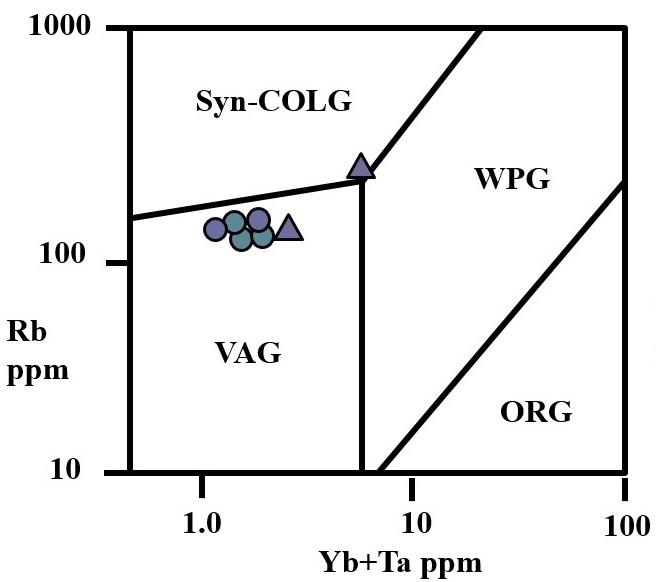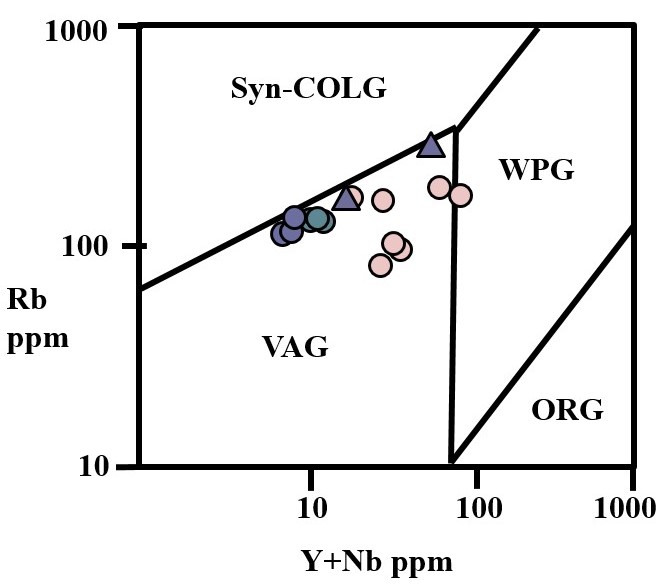Petrology,
Geochemistry, and Structural
Geology of Granites
Geology of Granites
Granites are intrusive igneous rocks with a felsic (high silica content) composition. Most of the time, granites and related rocks are developed by the differentiation of a magma. As a magma rests in the crust its mafic (magnesium and iron rich) components will crystallize first and as that magma rises it will rise more silica-rich until reaching a felsic composition through this distillation process. These granitic bodies can come in a wide variety of sizes from small stocks to large batholiths. Our group has been investigating the characteristics and origin of a group of granitic bodies in the Pennsylvanian Piedmont.
Field Mapping
 |
| Above is a generalized geologic map around the Philadelphia area showing the presence of granitic bodies. A larger granitic body, the Springfield granodiorite (pink), underlies much of the Philadelphia metropolitan area. North of the Springfield granodiorite, there are two small grandioritic bodies, the Girl Scout granodiorite (dark green) and the Bells Mill grandiorite (blue). These two granodiorite were the focus of a recent study in our research group. |
Mineralogy and Textures
| Basic classification of intrusive igneous rocks is based on bulk mineralogy. The rocks are examined and proportions of quartz (Q), plagioclase (P), and alkali feldspar (A) are plotted on a ternary diagram as seen to the right that has specific fields which define the rock type. Our investigation of the igneous bodies north of Philadelphia involved point counting minerals in thin-section to determine their mineral portions. It was found that both bodies are considered granodiorite, a slightly more intermediate (lower silica and higher magnesium and iron) version of granite. |  |
 |
Geochemistry and Origin of the Melt
Granitic melts can be created in a number of different geologic environments. By examining trace element concentrations and plotting the results on petrogenetic discrimination diagrams geologists can determine the likely source location for the melt.
 |
 |
 |
The discrimination diagrams shown use the relationships of trace elements to determine the source of granitic melts (Pearce et al., 1984; Pearce, 1996). The Piedmont granodiorites mainly plot in the Volcanic Arc Granite (VAG) field (other fields: ORG - Ocean Ridge Granite; Syn-COLG - Syn-Collisional Granite; and WPG - Within Plate Granite). These data suggest that the granodiorites may have been part of the island arc system. |
Components of this research have been presented at regional GSA:
- Hunsinger, C.F. and Kerrigan, R. J. (2017) Determining the Origin of Granodiorites in the Pennsylvania Piedmont using Geochemical and Petrographic Methods. Northeast and North-Central Joint
Section of the Geological Society of America, Abstracts with Programs, v. 49,
n. 2, pp. 26-13.
Future Projects on Pegmatites:
- Mapping the granitic bodies of the Pennsylvania Piedmont
- Using zircon geochronology to date the granitic bodies
- Characterizing the geochemistry of Piedmont granitic bodies
- Determining the origin of the Piedmont granitic bodies
- Linking the granitic bodies to their source magma
- More granitic bodies in other location
- Petrology and Geochemistry in Portugal
- Volcanic Ashes and Hydrothermal veining in the Alleghany Plateau
- Petrology, Geochemistry, and Structural Geology of Ultramafic Rocks
- Petrology, Geochemistry, and Structural Geology of Pegmatites
- Structural Geology of Large Fracture Zones in the Allegheny Plateau
- Environmental Assessment and Remediation
Top images (left to right): Geologic Map of the Youngsford Road ultramfic body; field work at Bells Mill Road with Ryan Kerrigan, Loring Simboli, and Sam Louderback; XPL image of orthopyroxene altering to anthophyllite; Secondary electron image of relict olivine altering to serpentine; field contact between the Bells Mill granodiorite and the Wissahickon schist; trace element chemical discrimination diagram for serpentinites. Copyright © 2024 Ryan Kerrigan (last updated Jun 2024)
